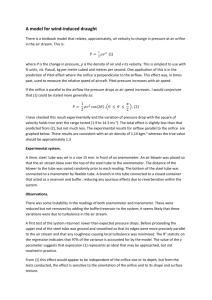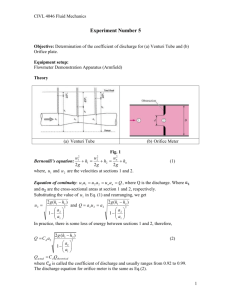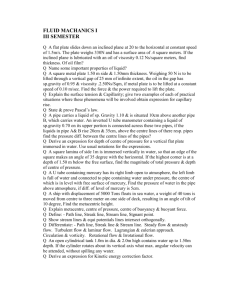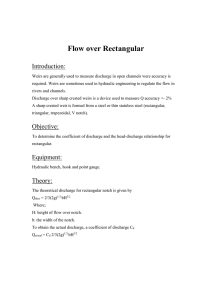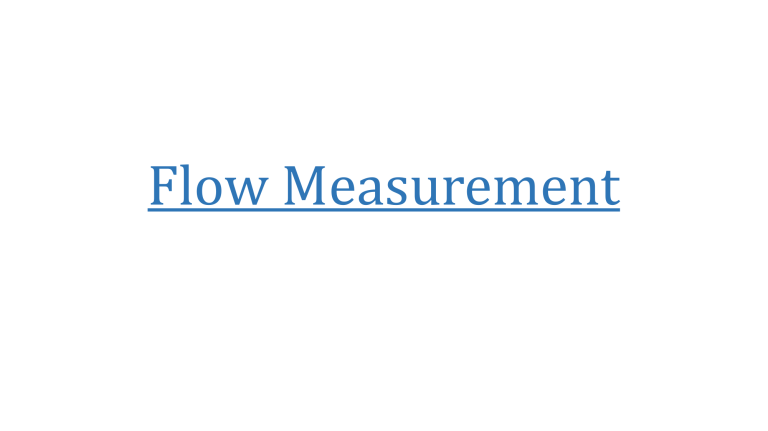
Flow Measurement Flow Measurement Devices Devices for Pipe flow (flow under pressure) Devices for Open Channels i. ii. iii. iv. v. i. Notches ii. Weirs iii. Pitot Tube Orifices Mouthpieces Nozzles Venturimeter Pitot Static Tube Orifice An orifice is an opening, usually circular, in the side or base of a tank or reservoir, through which fluid is discharged in the form of a jet, usually into the atmosphere. • Discharge depends on the Head ‘H’, size, shape and form of orifice. • Usually sharped edge is provided to reduce friction Whenever there’s discharge through the orifice, the streamlines converge at a particular section which is termed as vena contracta. This contraction depends on head, shape and size of orifice. Classification of Orifice According to size According to shape i. Small orifice (Do < H/5) i. Circular orifice ii. Large orifice (Do > H/5) ii. Rectangular orifice An orifice is termed as small when its size is small compared to head causing flow. The velocity does not vary appreciably from top to bottom edge of the orifice and is assumed to be uniform. iii. Square orifice The orifice is large if the dimensions are comparable with the head causing flow. The variation in the velocity from top to bottom edge is considerable. iv. Triangular orifice Classification of Orifice According to shape of upstream edge According to discharge condition i. Sharp-edged orifice i. Free discharge orifice ii. Bell-mouthed orifice ii. Submerged orifice Sharp edged orifice Bell mouth orifice Square (flat) orifice Fully Submerged Orifice Partially Submerged Orifice Its inner Its upstream edge Its upstream edge (upstream edge of is rounded. Due to is square. orifice is sharp) rounded shape friction is reduced. Orifice Vena Contracta The Vena Contracta is formed due to convergence of streamlines. The section of the jet in which the streamlines become parallel and the dia of jet is minimum (even less than the dia of orifice). The location is usually at a distance of (N x D) from the wall of tank. ( N is distance coefficient ≈ 0.5) Hydraulic Coefficients of Orifice i. Co-efficient of Contraction (Cc) ii. Co-efficient of velocity (Cv) iii. Co-efficient of discharge (Cd) Orifice Coefficient of Contraction The ratio between area of jet at Vena Contracta and area of orifice. Cc = For circular orifice ⇒ Cc = 𝜋 4 𝜋 4 𝐴𝑐 𝐴𝑜 𝐷𝐶2 𝐷𝑜 <1 2/D 2) = (D c o 2 Where, Dc = Dia. of contracted jet Do = Dia. of orifice Generally Cc ≈ 0.64 for sharped edge orifices but it varies between 0.61-0.69 depending on shape, size and head H over the orifice Torricelli’s Equation / Theorem Consider two sections: 1) A at the free surface & 2) B at the opening on the side near the right bottom of tank as shown. Let H= Head over the opening causing the flow v= Velocity of the fluid jet Applying Bernoulli's eq. at A & B 𝑃 zA + 𝐴 𝛾 + 2 𝑣𝐴 2𝑔 𝑃 = zB + 𝐵 𝛾 zA + 0 + 0 = zB + 0 + ⇒ H= 𝑣 𝐵2 2𝑔 2 𝑣𝐵 + 2𝑔 2 𝑣𝐵 2𝑔 (∵ zA – zB = H) ⇒ vth = 2𝑔𝐻 Torricelli’s equation states that the theoretical velocity is proportional to square root of H Orifice Co-efficient of Velocity The ratio between the actual velocity of jet of fluid at Vena Contracta and the theoretical velocity of jet. Cv = 𝑉𝑎𝑐𝑡 𝑉𝑡ℎ = 𝑉𝑎𝑐𝑡 2𝑔ℎ Generally Cv ≈ 0.98 for shaped edge orifices but it varies between 0.95-0.99 depending on shape, size and head H over the orifice Orifice Co-efficient of Discharge The ratio between the actual discharge from an orifice to the theoretical discharge of the orifice. x Generally Cd for sharp edge orifice is taken as 0.62, but it varies from 0.61 to 0.65 Experimental Determination of Hydraulic Coefficients Co-efficient of Discharge (Cd) • The water is allowed to flow through an orifice fitted to a tank under a constant head at H. • The water is collected in a measuring tank for the time t. • The height of water in the measuring tank is observed and noted. Qact = 𝐴𝑟𝑒𝑎 𝑜𝑓 𝑡𝑎𝑛𝑘 ∗ 𝐻𝑒𝑖𝑔ℎ𝑡 𝑜𝑓 𝑤𝑎𝑡𝑒𝑟 𝑖𝑛 𝑡ℎ𝑒 𝑡𝑎𝑛𝑘 𝑡𝑖𝑚𝑒 𝑜𝑓 𝑐𝑜𝑙𝑙𝑒𝑐𝑡𝑖𝑜𝑛 Cd = 𝑄𝑎𝑐𝑡 𝑄𝑡ℎ = 𝑄𝑎𝑐𝑡 𝐴𝑟𝑒𝑎 𝑜𝑓 𝑜𝑟𝑖𝑓𝑖𝑐𝑒 ∗ 2𝑔𝐻 Experimental Determination of Hydraulic Coefficients Co-efficient of Velocity (Cv) • Suppose C-C represents the vena contracta of the jet of water coming out of the orifice under constant head H. • Consider a liquid particle is at C-C when time t=0 and it takes the position P along the jet. Vertical distance = y = ½ gt2 y= ½ g (x2/V2) ⇒ V= Vth = 2𝑔𝐻 (t=x/V) 𝑔𝑥2 2𝑦 Experimental Determination of Hydraulic Coefficients Co-efficient of Contraction (Cc) As we know that: Cd = Cv x Cc ⇒ Cc = 𝐶𝑑 𝐶𝑣 Mouthpieces/Tubes • A tube/mouth piece is a short pipe whose length is not more than two or three times the diameter. • There is no sharp distinction between a tube and a thick walled orifice. • A tube may be of uniform diameter or it may diverge Nozzle A nozzle is a tube of changing diameter, usually converging as shown in figure if used for liquids. Pressure at 1 is P1 & Dia is D1 Pressure at 2 is P2 & Dia is D2 Nozzle Jet is a stream coming out of a nozzle, orifice or a tube. Nozzle (Head loss) z1 + P1 γ + v12 2g P = z2 + γ2 + v22 2g + hL = H (head causing flow) Since z1= z2 & P2 = 0 (atm), v1 = P1 v12 v22 + = γ 2g 2g 2𝑔𝐻 v22 2g 2 + hL = H v2 = Cv 2𝑔𝐻 v22 2g 1 ⇒ v22= Cv (2gH) ⇒H= V 22 x 1 2g Cv2 + hL = H + hL = V22 x 1 2g Cv2 hL = V22 x 1 V22 2g Cv2 2g hL = V22 x 2g 1 (C 2 - 1) v Head loss hL is a function of velocity head & Co-efficient of velocity of the nozzle. Venturimeter , Orifice Meter & Pitot Tube • Already discussed in previous topic Pitot tube: It measures sum of velocity head and pressure head Piezometer: It measures pressure head Pitot-Static tube: It is combination of piezometer and pitot tube. It can measure velocity head. In the pitot static tube, one tube is inserted inside the other bent tube. Inner tube acts as a pitot tube and outer as piezometric tube(s). The outer tube also has holes transverse to the direction of flow. Sometimes these tubes are also connected to differential manometer. Flow measurement in Open Channels Notches • Metallic • Doesn’t Raise W/L on d/s side • Smaller in size • Used in labs mostly Weirs • Concrete/Masonry structures • Raises W/L on d/s side • Bigger in size • Used in field Flow measurement in Open Channels Notch A notch may be defined as an opening in the side of a tank or vessel such that the liquid surface in the tank is below the top edge of the opening. A notch may be regarded as an orifice with the water surface below its upper edge. It is generally made of metallic plate. It is used for measuring the rate of flow of a liquid through a small channel of tank. Weir It may be defined as any regular obstruction in an open stream over which the flow takes place. It is made of masonry or concrete. The condition of flow, in the case of a weir are practically same as those of a rectangular notch. Nappe The sheet of water flowing through a notch or over a weir Sill or crest The top of the weir over which the water flows is known as sill or crest. Classification of Notches/Weirs Classification of Notches According to shape 1. Rectangular notch 2. Triangular notch 3. Trapezoidal Notch 4. Stepped notch Classification of Weirs According to shape Rectangular weir Trapezoidal weir (Cippoletti weir) According to nature of discharge Ordinary weir Submerged weir According to width of weir Narrow crested weir Broad crested weir According to nature of crest Sharp crested weir Ogee weir Discharge over Rectangular Notch/Weir H= Head of water over the crest L= Length of Notch or weir For finding Q, an elementary strip of thickness dh at depth h from free surface is selected. Area of strip= dh x L & Vth = 2𝑔ℎ The discharge through strip = dQ The total discharge can be found by integration between 0 and H. Discharge over Triangular Notch (V-Notch) The same procedure is applied for triangular notch as adopted for rectangular one with different geometry. Discharge over Trapezoidal Notch Trapezoidal notch is a combination of a rectangular & triangular notch. Discharge through trapezoidal notch is a summation of rectangular & triangular notch. Let, Cd1 = Co-efficient of discharge for rectangular portion Cd2 = Co-efficient of discharge for triangular portion Q = Q1 + Q 2 Discharge over Stepped Notch Stepped notch is a combination of a rectangular notches. Problem 1 The head of water over an orifice of diameter 40 mm is 10 cm. Find the actual discharge and actual velocity of the jet. Take Cd = 0.6 and Cv = 0.98 Problem 2 The head of water over an orifice of diameter 100 mm is 10 m. The water coming out of the orifice is collected in a circular tank of 1.5 m diameter. The rise of water in this tank is 1 m in 25 seconds. Also the coordinates of the point on the jet, measured from vena contracta are 4.3 m horizontal and 0.5 m vertical. Find Cd, Cv and Cc Problem 3 A pipe, 100 mm in diameter has a nozzle attached to it at the discharge end, the diameter of the nozzle is 50 mm. The rate of discharge of water through the nozzle is 20 litres/s and the pressure at the base of nozzle is 5.886 N/cm2. Calculate Cd. (Assume that the base of nozzle and outlet of nozzle are at the same elevation) Problem 4 The head of water over a rectangular notch is 900 mm. The discharge is 300 litres/s. Find the length of the notch, when Cd = 0.62 Problem 5 Water flows over a rectangular weir 1 m wide at a depth of 150 mm and afterwards passes through a triangular right angled weir. Taking Cd of rectangular and triangular weir as 0.62 and 0.59 respectively, find the depth over the triangular weir. Problem 6 Find the discharge through a trapezoidal notch which is 1m wide at the top and 0.4 m at bottom & is 30 cm in height. The head of water on the notch is 20 cm. Assume Cd for rectangular portion = 0.62 while for triangular portion = 0.60

